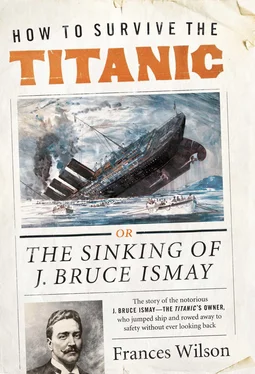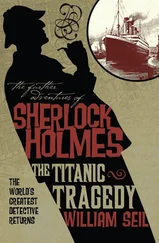Shaw, who had a reputation for building stately homes for businessmen (his customers would include a number of shipowners), also had shipping connections: his brother was a partner in Shaw Savill, a company specialising in runs to New Zealand, and during the construction of the Ismay house, White Star made a deal to provide the ships and crew for Shaw Savill’s New Zealand trade if they came up with the passengers.
Shaw’s legacy can be seen in London’s New Scotland Yard, the striped White Star offices in Liverpool, and the Tudorbethan houses of the stockbrocker belt. He built sturdy mansions for sturdy men and Dawpool, the mansion he built for Thomas Ismay, was, in the words of Shaw’s biographer Andrew Saint, ‘a monster perched on the headland’. 19Again and again, Dawpool, whose front alone measured 250 feet, is described in terms of monstrosity. It was built to be magnificent but, unlike the White Star liners, Dawpool’s treatment of its guests was indiscriminate. No one was comfortable; Dawpool was an exercise in strength and severity rather than in home-making. Florid at sea, Ismay Senior was austere on land. Dawpool’s immense mass, Saint writes, ‘palliated only by dark ivy patches clasping at the ruddy sandstone walling, started out from the barren heath, amidst outcrop, gravel, furze, heather and bracken’. The mood was ‘alternately fearsome and ghostly, lowering in shadow and rainfall, bleaching balefully in sunlight, in accord with the rich but chilly red of the Wirral sandstone from which it was fashioned’. 20Thomas had no interest in cultivating land, and the consequent lack of trees, gardens (he disliked flowers) and parkland increased the general aspect of brutalism.
Dawpool’s interior was equally sobering. The dining room, says Saint, was ‘reminiscent of those pictures by Orchardson in which the grandee and his bored wife dine in desperate solitude’. Shaw had ‘over-relied’ throughout on set-piece effects such as his trademark part-Tudor and part-Classic inglenooks. 21An enormous, palm-filled and panelled picture room, whose domed, glazed ceiling (‘an eyesore’, according to Margaret Ismay) appeared to be supported by a colossal chimneypiece constructed from two enormous church organs, served as a gallery for Thomas Ismay’s art collection, which included Rossetti’s The LovingCup. Keen to compete with collectors of contemporary art, Ismay Senior also had his portrait painted by John Everett Millais.
Costing £50,000 (£3.5 million in today’s money), the house took four years to build and was completed in 1886. It was not meant to be a working building in the heart of a great estate, but nor was it meant to be a family home. Dawpool was a show house, a stage set. The family, when they moved in with a newly acquired retinue of twenty-two indoor and ten outdoor servants, loathed it. Because there was no central heating and Thomas didn’t allow fires in the bedrooms until teatime, the house remained freezing for most of the year. When they were at last lit, the fires smoked so badly that, regardless of the weather, the windows had to be opened in order to release the fug. In these chilly rooms the unmarried Ismay daughters, forbidden by their father either to speak at table or to read the newspapers, sat sewing with their mother.
So pleased was he with Dawpool that in 1897 Thomas Ismay asked Shaw to design the interior of the White Star’s new flagship, named Oceanic after their first liner. This second Oceanic was to be the largest and most luxurious ship in the world and the first to exceed the tonnage of Brunel’s Great Eastern of 1860. Money was no object, and so Shaw duly equipped her with gold-plated light fittings, marble lavatories, Queen Anne mirrors, Adam fireplaces, Ionic pillars, a domed ceiling decorated with allegorical figures representing Great Britain, the United States, Liverpool and New York, an oak-panelled dining room awash with gold, further panels carved with fruit and flowers in the style of Grinling Gibbons and a bacchanalian procession. There was a magnificent ‘Turkey red’ central staircase, and a smoking room lined in highly embossed leather gilt, with a carved mahogany frieze depicting sea nymphs. The sea nymph theme continued in stained-glass sliding shutters, while the ceiling formed a double dome decorated with scenes from the life of Columbus, and marble Italian figures posed in the corner niches. The Oceanics passengers, one commentator said, might be in Haddon Hall, the famous Elizabethan manor in Derbyshire; this was the grand country-house style which would increasingly characterise the interiors of all the White Star liners. Only in third-class, with its narrow bunks and undisguised pipes and girders, did the ship still resemble a ship.
The problem for Thomas Ismay was that while he did not want to share his son’s company, he did want him involved in the family firm. To achieve both ends, the year after moving to Dawpool he sent Bruce, now aged twenty-one, to New Zealand aboard the newest White Star liner, the Doric. This was a luxury cruise rather than an adventure of the sort Thomas had enjoyed on the Charles Jackson. There were to be no drenchings or drinking songs, there was no joshing with the crew; the point of the journey was not to test Ismay’s mettle as a seaman but for him to see how the new service was working, and he was treated throughout with the wariness and respect due to the son of the owner. On his return to England nine months later, the position of manager of the White Star Line agency in New York became vacant and to keep him further out of his way, Thomas arranged that Bruce be given the job.
Three weeks after Ismay took up his new post he was confronted by his first maritime disaster. Two White Star ships, the Celtic and the Britannic, one on her way to Liverpool and the other on her way back, collided in poor weather and were badly damaged. The passengers panicked and the Captain was forced to use his gun to maintain order. The wounded liners limped back to New York in tandem, flashing lights and firing guns at one-minute intervals. An inquiry was held and the Captains of both ships were severely reprimanded for travelling at excessive speeds. Ismay, the representative of the company, was expected to issue the US press with information. It was a job to which he was ill-suited: Ismay loathed publicity and had never mastered the art of public speaking or self-presentation. He had a brusque, abrupt and imperious manner, and journalists — to whom he was always rude — saw him as arrogant, charmless and disdainful. But most striking was his inability to give a straight reply to a plain question. Ismay became famous amongst reporters on both sides of the pond for what the Financier called his ‘enigmatic’ non-answers. In its ‘Shipping Notes’, the paper described Ismay’s responses in an interview as ‘the luminous fog’ which ‘issued from his mouth’. But no one disliked Bruce Ismay as much as the press baron and man of the people, William Randolph Hearst (portrayed as Citizen Kane in the film by Orson Welles). The combination of Hearst’s hatred and Ismay’s luminous fog would result in his undoing.
Aside from unpopularity with the press, all we know of Ismay’s activities during his two years in New York is that they caused his parents concern. In Wilton Oldham’s words, he ‘painted the town very red indeed’, which probably means that he behaved much as any rich, handsome, unattached twenty-two-year-old male would do in a city 4,000 miles away from his oppressive father. The evidence suggests that Ismay was happy; he socialised, he made friends; he was away from English snobbery in a city where every man was a potential tycoon. He went to dances and concerts, and he indulged his love of expensive shoes and suits — Ismay, whose ‘clothes’, in the words of an employee, ‘were always perfect and his shoes a dream’, was described by the Boston Globe as ‘somewhat fond of club life and one of the best-dressed men in England’. 22When Thomas offered him a partnership in Ismay, Imrie and Co., the acceptance of which would require him to return to Liverpool, Bruce — to his father’s fury — turned it down.
Читать дальше












